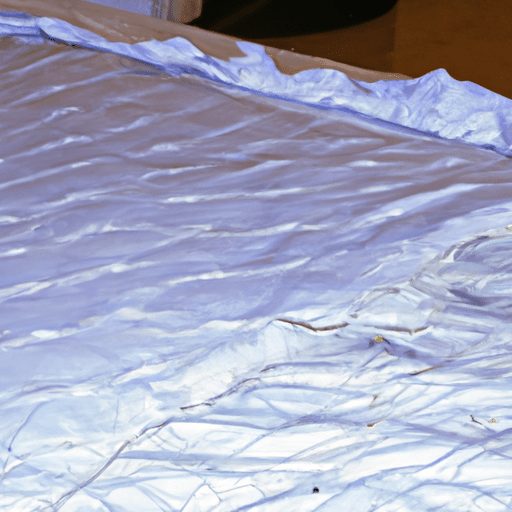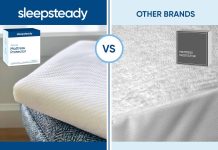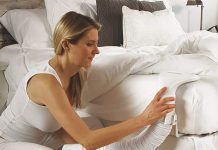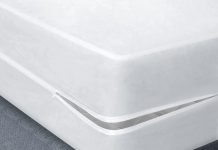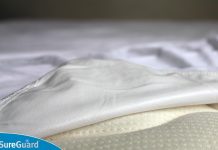Curious about how often to replace your mattress protector? We’ve got you covered! In this article, we dive into the world of mattress protectors and uncover the ideal timeline for their replacement. From understanding the importance of a clean and durable protector to discovering signs that it’s time for a fresh start, we’ll ensure your sleep environment remains cozy, clean, and allergen-free. So, let’s get started on uncovering the secrets behind a well-maintained mattress protector!
Review contents
Factors that affect the lifespan of a mattress protector
A mattress protector is an essential bedding accessory that helps to protect your mattress from spills, stains, dust mites, and allergens. However, just like any other product, the lifespan of a mattress protector can vary depending on several factors.
Quality of the mattress protector
The quality of the mattress protector plays a significant role in determining its lifespan. Higher-quality protectors made from durable materials are likely to last longer compared to lower-quality ones. Look for protectors that are made from waterproof and breathable fabrics with strong seams to ensure longevity.
Frequency of use
The more frequently you use your mattress protector, the faster it may wear out. If you use your mattress protector every night, it will be subject to more friction and potential damage compared to someone who only uses it occasionally.
Level of protection required
The level of protection required also affects the lifespan of a mattress protector. If you frequently spill liquids or have pets or young children who are prone to accidents, your mattress protector will be subjected to more wear and tear. In these cases, it may need to be replaced more often than if you only need basic protection from dust and allergens.
Maintenance and care
Proper maintenance and care are crucial for prolonging the lifespan of a mattress protector. Follow the manufacturer’s instructions for cleaning and washing the protector. Regularly washing and drying it on a gentle cycle will not only remove any stains or odors but also help to maintain its effectiveness and durability.
Signs that indicate it’s time to replace your mattress protector
While a good-quality mattress protector can last for several years, there are certain signs that indicate it’s time to replace it.
Visible wear and tear
Inspect your mattress protector regularly for any signs of wear and tear. Look for thinning fabric, loose or frayed seams, or any holes that may compromise its protective qualities. Over time, the constant use and washing can cause the material to become weaker, making it less effective in safeguarding your mattress.
Loss of functionality
If your mattress protector no longer serves its primary functions, it may be time to replace it. For example, if it has lost its waterproofing capabilities and is no longer protecting your mattress from spills, it’s time for a new one. Similarly, if you notice that the protector is no longer keeping allergens or dust mites at bay, it’s a sign that it needs to be replaced.
Allergies or sensitivities
If you or anyone in your household experiences increased allergy symptoms or sensitivities while using the mattress protector, it may be time to consider a replacement. Over time, allergens can accumulate on the protector’s surface and cause discomfort. Replacing the protector can help eliminate these issues and ensure a healthier sleep environment.
Unpleasant odors
If you notice persistent odors coming from your mattress protector, even after washing it, it could indicate a buildup of bacteria or mold. This can happen if the protector is not dried thoroughly after washing or if liquids seep through and are not promptly cleaned. Unpleasant odors can affect the overall sleep experience and indicate that it’s time for a fresh protector.
Recommended lifespan for different types of mattress protectors
The recommended lifespan of a mattress protector can vary depending on the type of material used. Here’s a general guideline for different types of protectors:
Vinyl mattress protectors
Vinyl mattress protectors are known for their durability and longevity. With proper care, they can last anywhere from 5 to 10 years. However, it’s crucial to ensure that the vinyl material is of high quality, as cheaper options may crack or tear over time.
Cotton mattress protectors
Cotton mattress protectors are soft, breathable, and provide natural protection. They generally have a lifespan of around 3 to 5 years. Regular washing and proper maintenance can help extend their longevity.
Polyester mattress protectors
Polyester mattress protectors are affordable and easy to maintain. On average, they can last for 2 to 3 years. However, the durability of polyester protectors can vary depending on the thread count and overall quality of the fabric.
Bamboo mattress protectors
Bamboo mattress protectors are eco-friendly, hypoallergenic, and offer excellent moisture-wicking properties. With proper care, they can last for 3 to 5 years. Regular washing on a gentle cycle and avoiding high heat during drying will help maintain their integrity.
Tips to prolong the lifespan of your mattress protector
While the lifespan of a mattress protector may vary, there are several steps you can take to maximize its longevity.
Follow washing instructions
Always follow the manufacturer’s washing instructions for your mattress protector. Typically, most protectors can be machine-washed on a gentle cycle with mild detergent. Avoid using bleach or harsh chemicals as they can damage the fabric. Additionally, it’s advisable to air dry the protector or use low heat in the dryer to prevent shrinkage or damage.
Use an additional protective layer
To minimize wear and tear on your mattress protector, consider using an additional protective layer. This can be in the form of a fitted sheet or an extra mattress pad. The extra layer will help distribute the impact of your body weight and reduce direct friction on the protector.
Avoid exposure to extreme conditions
Exposure to extreme conditions like excessive heat or cold can accelerate the breakdown of a mattress protector. Avoid placing your protector near direct sunlight or heat sources, as this can cause the material to become brittle or discolored. Similarly, avoid exposing it to freezing temperatures, as it can cause the fabric to become rigid and prone to damage.
Invest in a high-quality mattress protector
Investing in a high-quality mattress protector from the start can significantly impact its lifespan. Look for protectors that are made from durable materials and have additional features like waterproofing or hypoallergenic properties. While they may come at a higher price point, the longevity and added benefits make it a worthwhile investment.
Frequently asked questions about mattress protectors
Can I repair a damaged mattress protector?
In most cases, it is not recommended to repair a damaged mattress protector. Once the protective barrier is compromised, it may not be able to provide the same level of protection. It’s best to replace a damaged mattress protector to ensure continued effectiveness and hygiene.
Can I use a mattress protector on memory foam mattresses?
Yes, it is perfectly safe to use a mattress protector on memory foam mattresses. In fact, using a protector can help prolong the lifespan of your memory foam mattress by protecting it from spills and stains. Just make sure to choose a mattress protector that is suitable for use with memory foam to ensure proper ventilation and breathability.
Is a mattress protector necessary if I have a warranty?
Yes, a mattress protector is still recommended even if you have a warranty on your mattress. Most warranties require that you keep your mattress clean and free from stains. Using a mattress protector not only provides an additional layer of protection but also helps maintain the warranty validity.
Can I use a mattress protector with an electric blanket?
It is generally safe to use a mattress protector with an electric blanket. However, it’s crucial to follow the manufacturer’s instructions for both the mattress protector and the electric blanket. Ensure that the mattress protector does not interfere with the functioning of the electric blanket and that it does not pose a fire hazard.
Conclusion
A mattress protector is a valuable investment in maintaining the cleanliness and longevity of your mattress. Understanding the factors that affect its lifespan and knowing when to replace it will ensure that your mattress remains protected and comfortable for years to come. By choosing a high-quality protector, following proper maintenance and care, and being aware of signs of wear and tear, you can enjoy the benefits of a well-protected mattress and a restful sleep experience.

